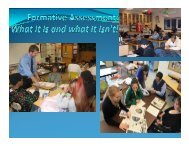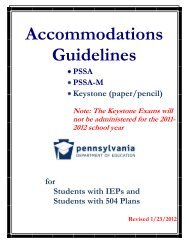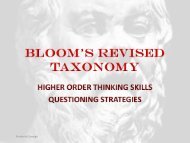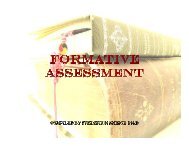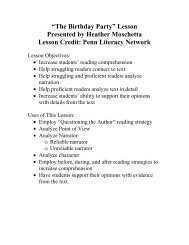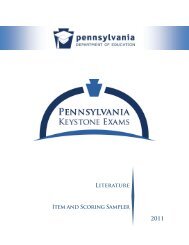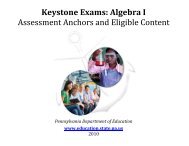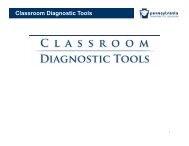FORMATIVE ASSESSMENT (Assessment for learning)
FORMATIVE ASSESSMENT (Assessment for learning)
FORMATIVE ASSESSMENT (Assessment for learning)
Create successful ePaper yourself
Turn your PDF publications into a flip-book with our unique Google optimized e-Paper software.
Teachers might also assess students' understanding in the following ways:<br />
Have students write their understanding of vocabulary or concepts be<strong>for</strong>e and after<br />
instruction.<br />
Ask students to summarize the main ideas they've taken away from a lecture, discussion,<br />
or assigned reading.<br />
Have students complete a few problems or questions at the end of instruction and check<br />
answers.<br />
Interview students individually or in groups about their thinking as they solve problems.<br />
Assign brief, in-class writing assignments (e.g., "Why is this person or event<br />
representative of this time period in history?)<br />
Additional sample strategies that teachers can use to gain in<strong>for</strong>mation about how well their<br />
students are <strong>learning</strong> are listed below.<br />
White boards: Teachers ask students to respond to questions by writing the answer on the<br />
boards. In addition, teachers could pose a multiple choice question and students write their<br />
choice on the board.<br />
Letter-cards: Each student is given a set of cards ranging from A-D, T, and F. The teacher poses<br />
a question and students choose their answer and show the appropriate card. True/False questions<br />
are also posed.<br />
Talk-Time: The teacher poses a question and students answer it in pairs. The teacher walks<br />
around the class as students are talking and gleans in<strong>for</strong>mation this way.<br />
Summarizing strategies: There many summarizing strategies that teachers can use to assess<br />
student understanding within a lesson (Popham, 2008)<br />
In addition to these classroom techniques, tests and homework can be used <strong>for</strong>matively if<br />
teachers analyze where students are in their <strong>learning</strong> and provide specific, focused feedback<br />
regarding per<strong>for</strong>mance and ways to improve it. Black and Wiliam (1998, Inside the Black Box)<br />
make the following recommendations:<br />
‣ Frequent short tests are better than infrequent long ones.<br />
‣ New <strong>learning</strong> should be tested within about a week of first exposure.<br />
‣ Be mindful of the quality of test items and work with other teachers and outside sources<br />
to collect good ones<br />
RECORD OBSERVATIONS<br />
Teachers may record the data collected through <strong>for</strong>mative assessment several times during the<br />
unit so they can observe patterns in student progress towards mastering the standard(s). There are<br />
many ways <strong>for</strong> teachers to record their observations from paper and pencil to technology based<br />
(spreadsheets, data bases) so they can look <strong>for</strong> patterns in their students’ <strong>learning</strong>.<br />
FLS Page 13



